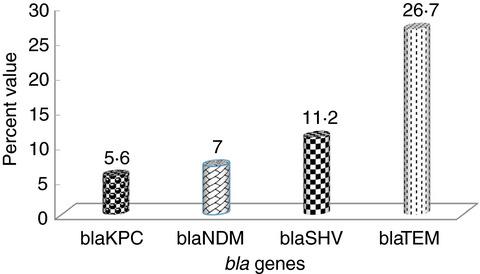当前位置:
X-MOL 学术
›
Lett. Appl. Microbiol.
›
论文详情
Our official English website, www.x-mol.net, welcomes your
feedback! (Note: you will need to create a separate account there.)
Carbapenemase and ESBL genes with class 1 integron among fermenting and non‐fermenting bacteria isolated from water sources from India
Letters in Applied Microbiology ( IF 2.0 ) Pub Date : 2019-11-08 , DOI: 10.1111/lam.13228 F Singh 1, 2 , S D Hirpurkar 1 , N Rawat 1 , S Shakya 3 , R Kumar 4 , S Kumar 4 , R K Meena 2 , P K Rajput 4 , J Kumar 2
Letters in Applied Microbiology ( IF 2.0 ) Pub Date : 2019-11-08 , DOI: 10.1111/lam.13228 F Singh 1, 2 , S D Hirpurkar 1 , N Rawat 1 , S Shakya 3 , R Kumar 4 , S Kumar 4 , R K Meena 2 , P K Rajput 4 , J Kumar 2
Affiliation

|
The present study was aimed to detect the carbapenemase, extended‐spectrum β‐lactamase (ESBL), and intI1 gene of class 1 integron among fermenting (n = 61) and nonfermenting (n = 10) bacterial isolates recovered from water samples (n = 128). Isolates were identified by 16S rRNA sequencing. These isolates showed reduced‐susceptibility to third‐generation cephalosporins and carbapenems. The isolates varied in number and size of plasmids (2 kb to >20 kb). Plasmid DNA screening showed 5·6, 7, 11·2 and 26·7% prevalence of blaKPC, blaNDM, blaSHV and blaTEM genes respectively. Diverse blaNDM (blaNDM‐1 and blaNDM‐4) and blaSHV subtypes (blaSHV‐2 and blaSHV‐11) were recorded, unlike the single allelic blaKPC (blaKPC‐2) and blaTEM (blaTEM‐1) gene. Of the total 27 bla‐gene‐producing bacterial isolates, seven isolates co‐harboured the carbapenemase genes (blaNDM or blaKPC or the both) along with the ESBL genes (blaSHV or blaTEM). The intI1 gene of class 1 integron was detected among 12 (44·4%) of ESBL‐ and/or carbapenemase‐harbouring isolates. Gene transferability was seen among four of the 10 Enterobacteriaceae donors. Carbapenemases and ESBLs with class 1 integron among aquatic environmental isolates raise the serious issue of the biosecurity and health of the ecosystem.
中文翻译:

从印度水源分离的发酵和非发酵细菌中具有 1 类整合子的碳青霉烯酶和 ESBL 基因
本研究旨在检测从水样中回收的发酵(n = 61)和非发酵(n = 10)细菌分离株中的碳青霉烯酶、超广谱 β-内酰胺酶(ESBL)和 1 类整合子的 intI1 基因(n = 128)。通过 16S rRNA 测序鉴定分离物。这些分离株对第三代头孢菌素和碳青霉烯类药物的敏感性降低。分离株的质粒数量和大小各不相同(2 kb 到 >20 kb)。质粒DNA筛选显示blaKPC、blaNDM、blaSHV和blaTEM基因的流行率分别为5·6、7、11·2和26·7%。记录了不同的 blaNDM(blaNDM-1 和 blaNDM-4)和 blaSHV 亚型(blaSHV-2 和 blaSHV-11),这与单一等位基因 blaKPC(blaKPC-2)和 blaTEM(blaTEM-1)基因不同。在总共 27 个产生 bla 基因的细菌分离株中,七个分离株同时携带碳青霉烯酶基因(blaNDM 或 blaKPC 或两者)以及 ESBL 基因(blaSHV 或 blaTEM)。在 12 株(44·4%)ESBL 和/或碳青霉烯酶携带分离株中检测到 1 类整合子的 intI1 基因。在 10 个肠杆菌科供体中的 4 个中观察到基因可转移性。水生环境分离株中含有 1 类整合子的碳青霉烯酶和 ESBL 引发了生态系统生物安全和健康的严重问题。
更新日期:2019-11-08
中文翻译:

从印度水源分离的发酵和非发酵细菌中具有 1 类整合子的碳青霉烯酶和 ESBL 基因
本研究旨在检测从水样中回收的发酵(n = 61)和非发酵(n = 10)细菌分离株中的碳青霉烯酶、超广谱 β-内酰胺酶(ESBL)和 1 类整合子的 intI1 基因(n = 128)。通过 16S rRNA 测序鉴定分离物。这些分离株对第三代头孢菌素和碳青霉烯类药物的敏感性降低。分离株的质粒数量和大小各不相同(2 kb 到 >20 kb)。质粒DNA筛选显示blaKPC、blaNDM、blaSHV和blaTEM基因的流行率分别为5·6、7、11·2和26·7%。记录了不同的 blaNDM(blaNDM-1 和 blaNDM-4)和 blaSHV 亚型(blaSHV-2 和 blaSHV-11),这与单一等位基因 blaKPC(blaKPC-2)和 blaTEM(blaTEM-1)基因不同。在总共 27 个产生 bla 基因的细菌分离株中,七个分离株同时携带碳青霉烯酶基因(blaNDM 或 blaKPC 或两者)以及 ESBL 基因(blaSHV 或 blaTEM)。在 12 株(44·4%)ESBL 和/或碳青霉烯酶携带分离株中检测到 1 类整合子的 intI1 基因。在 10 个肠杆菌科供体中的 4 个中观察到基因可转移性。水生环境分离株中含有 1 类整合子的碳青霉烯酶和 ESBL 引发了生态系统生物安全和健康的严重问题。











































 京公网安备 11010802027423号
京公网安备 11010802027423号